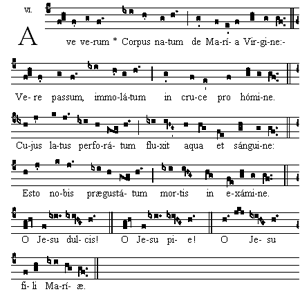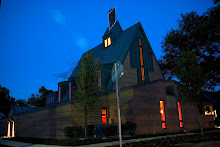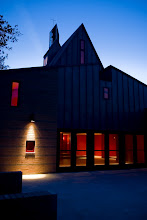Video for Responsorial Psalm of the 4th Sunday of Advent is now available.
Sunday, December 6, 2009
Responsorial Psalm for 4th Sunday of Advent
Responsorial Psalm for 3rd Sunday of Advent

News of Advent Lessons and Carols and Midnight Mass

Dear all,
There are great tidings of joy to be proclaimed:
First, the College will be having its annual Advent Lessons and Carols in the Chapel of Christ the Teacher on December 8th, 7:30pm. Please join us in this wonderful event.
************************************************************************************
Additionally, we will be blessed in having a Midnight Mass at the Chapel. Before this there will be Christmas caroling starting at 9:15pm, ending with O Silent Night and followed by the Mass itself. All are welcome to attend.
Monday, November 30, 2009
The History of the Advent Wreath by Fr. Wiliam Saunders

The History of the Advent Wreath
FR. WILLIAM SAUNDERS
The Advent wreath is part of our long-standing Catholic tradition. However, the actual origins are uncertain. There is evidence of pre-Christian Germanic peoples using wreathes with lit candles during the cold and dark December days as a sign of hope in the future warm and extended-sunlight days of Spring. In Scandinavia during Winter, lighted candles were placed around a wheel, and prayers were offered to the god of light to turn “the wheel of the earth” back toward the sun to lengthen the days and restore warmth.
By the Middle Ages, the Christians adapted this tradition and used Advent wreathes as part of their spiritual preparation for Christmas. After all, Christ is “the Light that came into the world” to dispel the darkness of sin and to radiate the truth and love of God (cf. John 3:19-21). By 1600, both Catholics and Lutherans had more formal practices surrounding the Advent wreath.
The symbolism of the Advent wreath is beautiful. The wreath is made of various evergreens, signifying continuous life. Even these evergreens have a traditional meaning which can be adapted to our faith: The laurel signifies victory over persecution and suffering; pine, holly, and yew, immortality; and cedar, strength and healing. Holly also has a special Christian symbolism: The prickly leaves remind us of the crown of thorns, and one English legend tells of how the cross was made of holly. The circle of the wreath, which has no beginning or end, symbolizes the eternity of God, the immortality of the soul, and the everlasting life found in Christ. Any pine cones, nuts, or seedpods used to decorate the wreath also symbolize life and resurrection. All together, the wreath of evergreens depicts the immortality of our soul and the new, everlasting life promised to us through Christ, the eternal Word of the Father, who entered our world becoming true man and who was victorious over sin and death through His own passion, death, and resurrection.
The four candles represent the four weeks of Advent. A tradition is that each week represents one thousand years, to sum to the 4,000 years from Adam and Eve until the Birth of the Savior. Three candles are purple and one is rose. The purple candles in particular symbolize the prayer, penance, and preparatory sacrifices and goods works undertaken at this time. The rose candle is lit on the third Sunday, Gaudete Sunday, when the priest also wears rose vestments at Mass; Gaudete Sunday is the Sunday of rejoicing, because the faithful have arrived at the midpoint of Advent, when their preparation is now half over and they are close to Christmas. The progressive lighting of the candles symbolizes the expectation and hope surrounding our Lord’s first coming into the world and the anticipation of His second coming to judge the living and the dead.
The light again signifies Christ, the Light of the world. Some modern day adaptions include a white candle placed in the middle of the wreath, which represents Christ and is lit on Christmas Eve. Another tradition is to replace the three purple and one rose candles with four white candles, which will be lit throughout Christmas season.
By the Middle Ages, the Christians adapted this tradition and used Advent wreathes as part of their spiritual preparation for Christmas.
In family practice, the Advent wreath is most appropriately lit at dinner time after the blessing of the food. A traditional prayer service using the Advent wreath proceeds as follows: On the First Sunday of Advent, the father of the family blesses the wreath, praying: O God, by whose word all things are sanctified, pour forth Thy blessing upon this wreath, and grant that we who use it may prepare our hearts for the coming of Christ and may receive from Thee abundant graces. Who livest and reignest forever. Amen.” He then continues for each of the days of the first week of Advent, O Lord, stir up Thy might, we beg thee, and come, that by Thy protection we may deserve to be rescued from the threatening dangers of our sins and saved by Thy deliverance. Who livest and reignest forever. Amen.” The youngest child then lights one purple candle.
During the second week of Advent, the father prays: O Lord, stir up our hearts that we may prepare for Thy only begotten Son, that through His coming we may be made worthy to serve Thee with pure minds. Who livest and reignest forever. Amen.” The oldest child then lights the purple candle from the first week plus one more purple candle.
During the third week of Advent, the father prays: O Lord, we beg Thee, incline Thy ear to our prayers and enlighten the darkness of our minds by the grace of Thy visitation. Who livest and reignest forever. Amen.” The mother then lights the two previously lit purple candles plus the rose candle.
Finally, the father prays during the fourth week of Advent, O Lord, stir up Thy power, we pray Thee, and come; and with great might help us, that with the help of Thy grace, Thy merciful forgiveness may hasten what our sins impede. Who livest and reignest forever. Amen.” The father then lights all of the candles of the wreath.
Since Advent is a time to stir-up our faith in the Lord, the wreath and its prayers provide us a way to augment this special preparation for Christmas. Moreover, this good tradition helps us to remain vigilant in our homes and not lose sight of the true meaning of Christmas.
(To see the direct source, go to: http://www.catholiceducation.org/articles/religion/re0132.html)
Thursday, November 19, 2009
A Wonderful Website for learning the Proper Chants for the Sundays
Here is the wonderful website for the Propers: http://isaacjogues.org/chants/
Now you may ask...
"What are 'the Propers" in the Mass?" -That is a good question.
Here is the answer: The Proper of the Mass, strictly speaking, consists of the Introit, Gradual, Alleluia or Tract, Sequence, Offertory, and Communion.
The Ordinaries are as follows:
(The following parts, if not sung by the whole congregation, are traditionally sung by a choir)
1. Kyrie eleison ("Lord, have mercy")
2. Gloria ("Glory to God in the highest")
3. Credo ("I believe in one God"), the Nicene Creed
4. Sanctus ("Holy, Holy, Holy"), the second part of which, beginning with the word "Benedictus" ("Blessed is he"), was often sung separately after the consecration, if the setting was long. (See Benedictus for other chants beginning with that word.)
5. Agnus Dei ("Lamb of God")
Monday, November 16, 2009
From the Loft: Mass of the 33rd Sunday in Ordinary Time
Following the ringing of the bells at the Chapel of Saint Thomas More, the Catholic hymn "O Sacred Heart of Jesus, Hear" was sung. This hymn is abbreviated from a melody by Louis Bourgeois (d. circa 1561); the prayer set to this melody, however, was written by Isabel Williams (d. 1911)--a wonderful example of how medieval melodies and modern prayers can be brought together to make what is sacred music--that which is eternal music. And of course, the Chant Mass Setting was sung along with Rossini's propers for the Gradual, Communion, and Introit. For communion, the choir was able to sing to Jesus and lift the souls of men to God in the beautiful work "Adoramus te, Christe" by Francois Clement Theodore Bubois (1837-1924). The English translation for this communion prayer is (thank you, William Mahrt!) "We adore thee, O Christ, and we bless thee: because by the holy cross thou hast redeemed the world." Immediately after this came the sublime "Ave Verum Corpus," which has been ascribed to Pope Innocent VI, d. 1362. It is in Mode 6, for all those who understand what that means! For a fitting close to this morning's Mass, the mighty hymn "Lift High the Cross" resounded through the chapel; it was followed by a roaring postlude from the new Johannus organ.
From the Loft,
Mr. Kochel
Note: Below is the translation of the wonderful chant "Ave Verum Corpus":
born of the Virgin Mary:
Truly suffered,
died on the cross for mankind:
From whose pierced side
flowed water and blood!
Be for us a foretaste
of death in the last hour!
O gentle Jesus!
O holy Jesus!
O Jesus, Son of Mary!"
Sunday, November 15, 2009
Responsorial Psalm for the Feast of Christ the King
Salve,
This is the Responsorial Psalm for the Feast of Christ the King that will be sung at the College's chapel, namely, the Chapel of Christ the Teacher.
Special thanks to Mr. Aristotle A. Esguerra for the psalm music.
I encourage to visit his site at: http://www.cantemusdomino.net/
Friday, November 13, 2009
Gregorian Chant could save your life!
Interestingly enough, reports have found that "Gregorian chanting 'can reduce blood pressure and stress'"
Stress levels could be reduced simply by participating in some Gregorian chanting, researchers claimed today.
Dr Alan Watkins, a senior lecturer in neuroscience at Imperial College London, revealed that teaching people to control their breathing and applying the musical structure of chanting can help their emotional state.
He said: "We have recently carried out research that demonstrates that the regular breathing and musical structure of chanting can have a significant and positive physiological impact."
Monks of Stift Heiligenkreuz
The monks of Stift Heiligenkreuz sing Gregorian melodies on their new album - the chants are said to reduce stress levels
The research involved five monks having their heart rate and blood pressure measured throughout a 24-hour period.
Results showed their heart rate and blood pressure dipped to its lowest point in the day when they were chanting.
Dr Watkins pointed to previous studies that also demonstrated such practices have been shown to lower blood pressure, increase performance hormone levels as well as reduce anxiety and depression.
The lecturer also runs Cardiac Coherence Ltd, a company that helps executives perform under stressful conditions.
He said: "The control of the breathing, the feelings of wellbeing that communal singing bring, and the simplicity of the melodies, seem to have a powerful effect on reducing blood pressure and therefore stress."
"We have found that teaching individuals to control their breathing, generate more positive emotional states and connect better with those around them – all key aspects of Gregorian chanting – can significantly improve their mental state, reduce tension, and increase their efficiency in the workplace."
Record company Universal recently chose the monks of Stift Heiligenkreuz, Vienna to make an album after responding to a public interest in the genre.
The company also believes the Halo computer game series, available on PCs and Xbox consoles, sparked a resurgence in the music traditionally sung in male church choirs, as Gregorian chant-like melodies form the main soundtrack of the games.
Read more: http://www.dailymail.co.uk/sciencetech/article-563533/Gregorian-chanting-reduce-blood-pressure-stress.html
Monday, November 9, 2009
Sunday, November 8, 2009
From the Loft: Mass in the Chapel, part ii
As I wish to relate the sacred music which descends from the choir loft at the typical 10 AM Mass, I will offer this description of today's liturgical menu:
First, of course, there was the main dish of Ordinary chants for the Mass setting in Latin. It was surrounded by a selection of traditional hymns, such as "Sing of Mary, Pure and Holy" (processional), "O Salutaris Hostia" (Communion, and O Queen of the Holy Rosary (recessional), these being found in the Adoramus and the New St. Basil Hymnal. In addition to all this lovely music, I was delighted to accompany on organ Mrs. Sharon Kirk and Miss Katherine Altham sweetly singing "Meditabitor", one of Fr. Carlo Rossini's two-voiced Offertory motets. All this being good and true, we renew our intention of bringing to the Mass the best which the handmaiden of the liturgy (ie, the sacred music) has to offer, this being Gregorian Chant, sacred polyphony, and Catholic hymns.
From the Loft,
Mr. Richard Kochel
PS: Seen in photo: Mr. Mark Bosse, altar server, reading the epistle

Wednesday, November 4, 2009
Pure Appreciation: Margaret
Indeed, I would like to show my appreciation for all those that share in the Sacred Music Program.
For this month, I have selected Margaret, an alto from our choir.
Margaret joined the choir in 2009. She is a new member, servicing the choir by singing down with the congregation, allowing her voice to help lead others in prayer. Dedication in this lady is a virtue that inspires both myself and all those that are in the choir, for she does not have a car, but a scooter in which she must travel to get to church on Sundays.
On behalf of the choir, I would like to say to her: Thank you, Margaret, and keep singing to the glory of God and for edification of the people!
God bless you.
From the Loft,
Mr. Kochel






